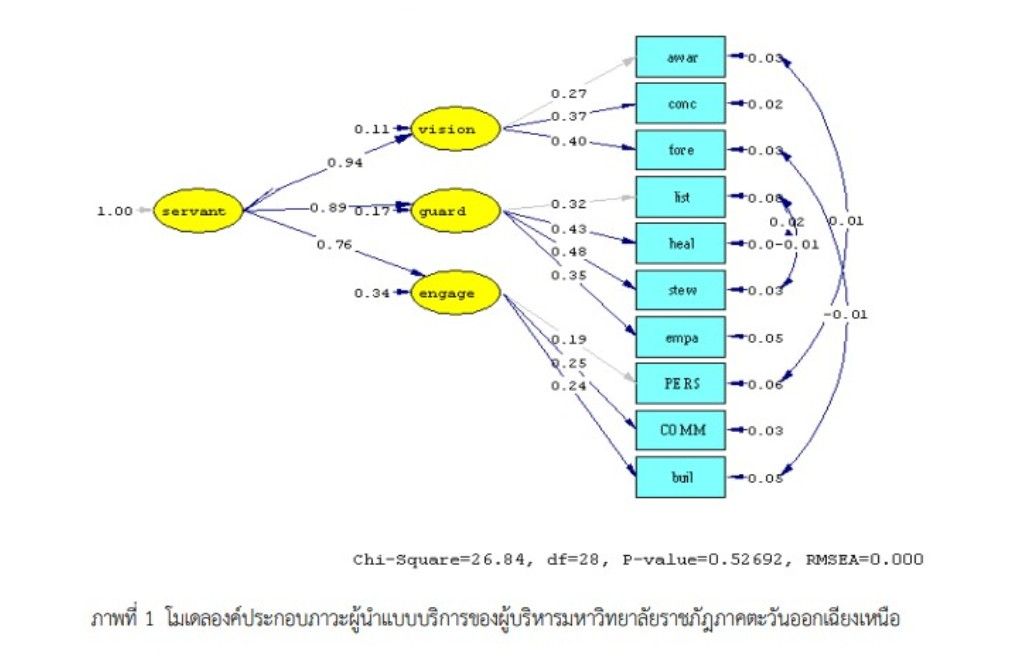การวิเคราะห์องค์ประกอบภาวะผู้นำแบบบริการของผู้บริหารมหาวิทยาลัยราชภัฏ ในภาคตะวันออกเฉียงเหนือ
Main Article Content
บทคัดย่อ
การวิจัยครั้งนี้มีวัตถุประสงค์เพื่อวิเคราะห์องค์ประกอบภาวะผู้นำแบบบริการของผู้บริหารมหาวิทยาลัยราชภัฏในภาคตะวันออกเฉียงเหนือ โดยใช้ระเบียบวิธีการวิจัยเชิงบรรยาย เก็บรวบรมข้อมูลเชิงปริมาณจากกลุ่มตัวอย่างผู้บริหารในมหาวิทยาลัยราชภัฏ จำนวน 260 คน เครื่องมือเก็บรวบรวมข้อมูลเป็นแบบสอบถามมาตรประมาณค่า ใช้โปรแกรมสำเร็จรูปในการวิเคราะห์สถิติเชิงพรรณนา และการวิเคราะห์องค์ประกอบเชิงยืนยันอันดับสอง ผลการวิจัยพบว่า ผลการทดสอบความสอดคล้องของโมเดลโครงสร้างภาวะผู้นำแบบบริการของผู้บริหารมหาวิทยาลัยราชภัฏในภาคตะวันออกเฉียงเหนือ โดยใช้ค่า ไค-สแควร์ ค่าดัชนีวัดระดับความกลมกลืน และค่าดัชนีวัดระดับความกลมกลืนที่ปรับแก้แล้ว โดยโมเดลมีความสอดคล้องกับข้อมูลเชิงประจักษ์อย่างมีนัยสำคัญทางสถิติ (Chi-Square = 26.84, ค่า df = 28, p = 0.53, GFI = 0.98, AGFI = 0.96, RMSEA = 0.00) ยืนยันสมมติฐานการวิจัยที่กำหนดไว้
Article Details
เอกสารอ้างอิง
นงลักษณ์ วิรัชชัย. (2542). ความสัมพันธ์โครงสร้างเชิงเส้น (Lisrel) : สถิติวิเคราะห์สำหรับการวิจัยทางสังคมศาสตร์และพฤติกรรมศาสตร์. พิมพ์ครั้งที่ 2. กรุงเทพฯ : โรงพิมพ์แห่งจุฬาลงกรณ์มหาวิทยาลัย.
บังอร ไชยเผือก. (2550). การศึกษาคุณลักษณะของผู้นำแบบผู้รับใช้และบรรยากาศของโรงเรียนคาทอลิกสังกัดคณะภคินีพระกุมารเยซู. สารนิพนธ์ปริญญาการศึกษามหาบัณฑิต สาขาวิชาการบริหารการศึกษา บัณฑิตวิทยาลัย มหาวิทยาลัยศรีนครินทรวิโรฒ.
สรายุทธ กันหลง. (2553). ยุทธศาสตร์การพัฒนาภาวะผู้นำใฝ่บริการของผู้บริหารมหาวิทยาลัยราชภัฏในภาคตะวันออกเฉียงเหนือ. วิทยานิพนธ์ปริญญารัฐประศาสนศาสตรดุษฎีบัณฑิต มหาวิทยาลัยราชภัฏวไลยลงกรณ์ ในพระบรมราชูปถัมภ์.
สัมฤทธิ์ กางเพ็ง และสรายุทธ กันหลง. (2553). ภาวะผู้นำใฝ่บริการในองค์การ: แนวคิด หลักการ ทฤษฎี และงานวิจัย. พิมพ์ครั้งที่ 2. ขอนแก่น: คลังนานาวิทยา..
Black, G. L. (2007). A Correlational Analysis of Servant Leadership and School Climate. Ed.D. dissertation, University of Phoenix, United States -- Arizona. Retrieved January 31, 2020, from Dissertations & Theses: A&I database. (Publication No. AAT 3309254).
Brown, S. (1999). Assessment matters in higher education : choosing and using diverse approaches. Philadelphia, PA : Society for Research into Higher Education & Open University Press.
Daft, R. L. (2005). The Leadership Experience. 3rded. Mason, OH : Thomson South-Western.
Dennis, R, Winston, B.E. (2003). A factor analysis of Page and Wong's servant leadership instrument. Leadership & Organization Development Journal, 24(7/8), 455-459. Retrieved December 22, 2008, from ABI/INFORM Global database. (Document ID: 521138211).
Greenleaf, R.K. (1977). The Servant Leadership: A Journey into the Nature of Legitimate Power and Greatness. New York: Paulist Press.
Greenleaf, R.K. (1977). The Servant Leadership: A Journey into the Nature of Legitimate Power and Greatness. New York: Paulist Press.
Greenleaf, R.K. (1998). Servant Leadership. In L.C. Spears (Ed.), Insights on Leadership : Service, stewardship, spirit, and Servant –Leadership. (pp. 15-20) New York : John Wiley & Sons Inc.
Greenleaf, R.K. (2002). Servant Leadership: A Journey into the Nature of Legitimate Power and Greatness. NJ: Paulist Press.
Hair, J. F., Black, W. C., Babin, B. J. & Anderson, R. E. (2010). Multivariate Data Analysis (7th ed.). Upper Saddle River, NJ: Prentice Hall.
Irving, J. A. (2005). Servant leadership and the effectiveness of teams. Doctoral dissertation, Regent University.
Johnson, D. P. (2004). The superintendent’s role in developing a positive school district climate (Doctoral dissertation, University of St. Thomas, Minnesota, 2004). Dissertation Abstracts International, 65(07), 132. (UMI No. 3141570)
Laub, J. A. (2000). Development of the Organizational Leadership Assessment (OLA) Instrument. Doctor of Education Dissertation in Education, Florida Atlantic University.
Lawrence, L.J. (2002). “For Truly, I Tell You, They Have Received Their Reward” (Ma th 6:2) Investigating honor precedence and honor virtue the Catholic Biblical Quarterly, 64-687.
Maxwell, J.C. (1999). The 21 indispensable qualities of a leader: becoming the person that people will want to follow. Nashville, TN: Thomas Nelson.
Nwogu, O.G. (2004). Servant Leadership Model : The Role of Follower Self-esteem, Emotional Intelligence, and Attributions on Organizational Effectiveness. Servant Leadership Research Roundtable. Regent University.
Page, Don; and Wong, Paul T.P. (2003) A Conceptual Framework for Measuring Servant Leadership. Trinity Western University, Canada. Retrieved on December 2021 from http://www.twu.ca/academics/graduate/leadership/servant-leadership/conceptualframework.pdf
Palmer, P. (2004). A Hidden Wholeness: The journey toward an undivided life. San Francisco, CA: Jossey-Bass.
Patterson, K. A. (2003). Servant Leadership: A Theoretical Model. Ph.D. dissertation, Regent University, United States -Virginia. Retrieved December 22, 2008, from ABI/INFORM Global database. (Publication No. AAT 082719).
Pituch, K.A. and Stevens, J.P. (2015). Applied multivariate statistics for the social sciences: Analyses with SAS and IBM‘s SPSS (6th ed). New York: Routledge.
Ramer, L. M. (2008). Using Servant Leadership to Facilitate Healing After a Drug Diversion Experience. Association of Operating Room Nurses. AORN Journal, 88(2), 253-8. Retrieved December 22, 2008, from ProQuest Health and Medical Complete database. (Document ID: 1538599511).
Spears, L.C. (1995). “Servant – Leadership and the Greenleaf”, in Spears, L (Ed) Reflections on Leadership: How Robert K. Greenleaf’s Theory of Servant – Leadership Influenced Today’s Top Management Thinker, John Wiley & Sons, Inc., New York, NY, pp. 1-14.
Spears, L.C. (2004). Practicing servant-leadership. Leader to Leader, 2004(34).ABI/INFORM Global database. (Document ID: 724827821).
Spears, L.C. and J. Noble. (2000). James Autry in Des Moines, Iowa. Retrieved on November 2021 from http://www.greeneaf.org/leadership/read-about-it/Servant-Leadership-Articles-Book-Reviews.html
Thompson, B. (2004). Exploratory and confirmatory factor analysis. Washington, DC: American Psychological Association.
Yalom, I.D. (1995). The theory and practice of group psychology (4th ed.) New York : Basic Books.
Yukl. G. (2010). Leadership in Organizations. 7th ed. Upper Saddle River, NJ : Pearson Prentice Hall.
Yukl. G. (2002). Leadership in Organizations. 5th ed. Englewood Cliffs, NJ : Prentice-Hall.


